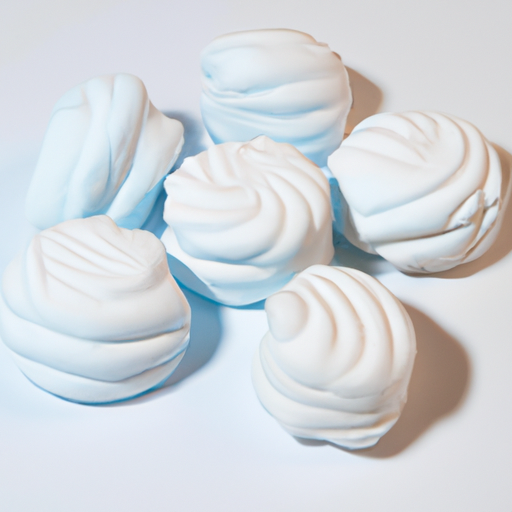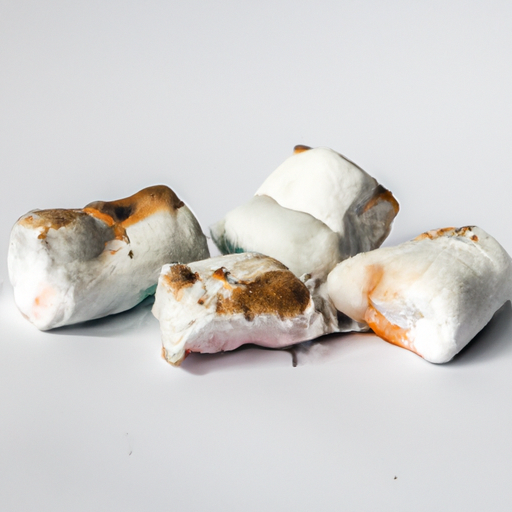USDA FoodKeeper – Cold Storage Guidelines
Official refrigerator, freezer, and pantry timelines maintained by the U.S. Department of Agriculture.
Visit USDA FoodKeeperFluffy and sweet, these delightful treats bring joy to campfires and desserts alike. With a shelf life of up to a year, they can be a staple in your pantry, but remember to check for freshness even after that expiration date—enjoy them safely for an extra month!
30 most common foods with instant answers. Print it and stick it on your fridge—completely free! Want more? Upgrade to the complete guide with 70+ foods.
"According to USDA guidelines, marshmallows should be stored in a cool, dry place at room temperature and used within 2 months for best quality."


Pantry
68°F (20°C)
Keep in original packaging or airtight container.
365 days
Hardening, off smell, mold growth
S'mores, hot chocolate topping, rice krispie treats
Other soft candies like gummy bears
Marshmallows typically have a long shelf life due to their high sugar content, which acts as a preservative. The expiration date on the packaging indicates when the marshmallows may start to lose their freshness and texture. While marshmallows may still be safe to consume after the expiration date, they might become stale, hard, or lose their fluffy texture. Best quality refers to the peak flavor and texture of marshmallows, which is usually within the first few months of purchase. Consuming marshmallows within this timeframe ensures the best taste and mouthfeel.
To determine if marshmallows have gone bad, look for any signs of mold, discoloration, or an off smell. Fresh marshmallows should be soft, fluffy, and white in color. If they appear dried out, hardened, or have an unusual odor, it's best to discard them.
Marshmallows are considered a low-risk food in terms of foodborne illnesses due to their high sugar content and low water activity, which inhibits bacterial growth. However, marshmallows may become contaminated if exposed to moisture or stored improperly. It is essential to keep marshmallows in a cool, dry place and away from potential sources of contamination, such as raw meats or other odorous foods. Additionally, marshmallows that have been stored for an extended period or show signs of mold growth should be discarded to prevent any potential health risks.
To maintain the freshness and texture of marshmallows, it is recommended to store them in an airtight container or resealable plastic bag to prevent exposure to moisture and air. Adding a desiccant packet or a few saltine crackers to the storage container can help absorb any excess moisture and keep the marshmallows soft and fluffy. If marshmallows become stale, you can revive them by placing a slice of bread or a damp paper towel in the container overnight to help restore their moisture content.
Marshmallows have a fascinating history that dates back to ancient Egypt, where a sweet treat made from the sap of the marshmallow plant was enjoyed by the pharaohs. Modern marshmallows are made from sugar, corn syrup, and gelatin, giving them their iconic fluffy texture. In the United States, marshmallows are a popular ingredient in s'mores, hot chocolate, and various desserts. They are also a staple in camping traditions and holiday celebrations, such as Easter and Halloween.
If Marshmallows have been left out at room temperature for several hours, they are generally safe to eat as they have a low risk level. However, prolonged exposure to air may cause them to dry out and lose their freshness. Check for any changes in texture or appearance before consuming.
Once opened, Marshmallows can typically be consumed for up to 30 days past the initial opening date if stored properly in a sealed container in the pantry. Check for any signs of spoilage such as odd smells, changes in texture, or mold growth before consuming.
The type of container you store Marshmallows in can impact its shelf life. Airtight containers help maintain freshness and prevent moisture loss, extending the shelf life. Avoid storing Marshmallows in open bags or containers that allow air exposure, leading to quicker staleness.
Marshmallows are resilient to temperature changes due to their low-risk level. Exposing them to varying temperatures, such as moving from the pantry to room temperature, should not significantly impact their safety. However, fluctuations may affect texture and quality over time.
Cooking Marshmallows, such as roasting them over a fire, does not impact their expiration date. However, the texture and taste may change after heating. It is safe to consume cooked Marshmallows within their shelf life, ensuring they are not burnt or contaminated during the cooking process.
It is generally safe to store Marshmallows next to other foods in the pantry as they have a low risk level and do not easily spoil. However, to prevent flavor transfer, it's advisable to keep strongly scented or flavored items separate from the Marshmallows to maintain their original taste.
While the basic composition of Marshmallows remains similar across brands, variations in preservatives or additives can affect shelf life. It's essential to refer to the expiration date and storage instructions provided by each specific brand to ensure optimal freshness and safety.
The shelf life of Marshmallows remains relatively stable regardless of the season due to their low-risk nature and pantry storage. However, exposure to extreme heat in summer may lead to quicker spoilage or melting, so it's advisable to store them in a cool, dry place year-round.
When transporting Marshmallows for a few hours, place them in a sealed container to prevent exposure to air and moisture. If traveling in hot weather, consider using a cooler bag or ice pack to maintain their shape and freshness. Avoid crushing or compressing the Marshmallows during transit.
30 most common foods with instant answers. Print it and stick it on your fridge—completely free! Want more? Upgrade to the complete guide with 70+ foods.
Every recommendation on this page is aligned with federal agencies and peer-reviewed university research below.
Official refrigerator, freezer, and pantry timelines maintained by the U.S. Department of Agriculture.
Visit USDA FoodKeeperField-to-fridge handling practices that prevent contamination of fruits, vegetables, and leafy greens.
Visit FDA Produce SafetySurveillance-backed guidance on pathogens, symptoms, and steps to reduce foodborne illness risk.
Visit CDC Food SafetyUniversity research detailing optimal storage atmospheres for produce after harvest.
Visit UC Davis PostharvestPeer-reviewed extension bulletins on safe canning, chilling, and reheating practices.
Visit Penn State ExtensionNeed deeper reading? Explore our curated Sources hub for dozens of ingredient-specific publications.
Scan your food directly and get instant safety info using our AI-powered camera feature.
We have recipes that can help you safely use marshmallows past its expiration date!
View Recipes →Cooking Ingredients
View expiration date and storage guide →
Beverages
View expiration date and storage guide →
Grains & Pasta
View expiration date and storage guide →
Instant Foods
View expiration date and storage guide →
Condiments & Spices
View expiration date and storage guide →
Fruits & Vegetables
View expiration date and storage guide →
Baking Supplies
View expiration date and storage guide →
Condiments & Spices
View expiration date and storage guide →
Canned & Jarred Goods
View expiration date and storage guide →
Important: These are general guidelines based on authoritative sources listed above. Always use your best judgment and when in doubt, throw it out. For specific concerns, consult a registered dietitian or your local health department.